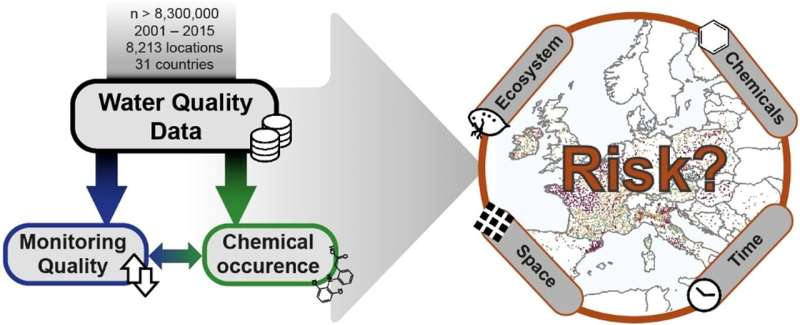Chemical status of European surface waters decreases while monitoring improves

The Water Framework Directive was enacted in 2000 with the goal of protecting and restoring aquatic ecosystems to a "good ecological status." Alongside this monumental water policy effort, large amounts of environmental monitoring data were gathered to track the occurrence of organic contaminants in Europe. For the first time, this large dataset comprising of more than 8 million measurements of 352 organic contaminants in 31 countries over the last 15 years was comprehensively analyzed to deduce both the status and trends of European freshwater integrity.
"We have analyzed several million of water quality measurements detailing the occurrence of organic contaminants throughout Europe over the last 15 years and assessed the risks that are posed to freshwater environments," says the lead author Jakob Wolfram, scientist at the Institute for Environmental Sciences in Landau. "Our study found that governmental monitoring improves, yet freshwater systems remain frequently impaired by exposures to numerous organic contaminants and for some important organism groups these conditions continue to deteriorate."
In this extensive analysis, it was found that most types of organic contaminants, such as industrial chemicals, pesticides and pharmaceuticals, are increasingly found in surface waters. Only one third of water bodies were not contaminated by any organic contaminants in a given year. Upon closer inspection of these sites, it was found that monitoring was substantially less reliable there, likely resulting in failure to detect many relevant contamination events. As a result, the quality of monitoring was compared between countries and shown to be linked to the degree to which contaminants were found in the field. These results suggest that in many countries the true exposure of organic contaminants remains severely underestimated until monitoring efforts improve.
Pesticides remain the dominant factor adversely impacting European freshwaters, causing 85% of ecological threshold exceedances. As a result, water bodies in areas dominated by agriculture were shown to experience the highest pollution that threatens ecosystem integrity. Overall, at 35% of sites an ecological threshold was exceeded in a given year, resulting in 38% of waterbodies being impaired ecologically. While pharmaceuticals did not appear to pose substantial short-term risks, their regular presence could cause long-term effects in aquatic communities that are currently still mostly unknown.
According to the authors, freshwater ecosystems remain at risk in Europe, particularly for aquatic fish, insects, and crustaceans. Jakob Wolfram adds: "Our results highlight that despite the concerted effort of the Water Framework Directive, further invigorated efforts are now needed to curb the environmental pollution of freshwaters."
More information: Jakob Wolfram et al. Water quality and ecological risks in European surface waters – Monitoring improves while water quality decreases, Environment International (2021). DOI: 10.1016/j.envint.2021.106479
Journal information: Environment International
Provided by Universität Koblenz-Landau


















